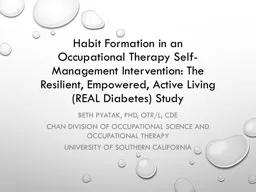

Beth Pyatak PhD OTRL CDE Chan Division of Occupational Science and Occupational Therapy University of Southern California What is occupational t herapy OT Facilitates participation in everyday activities ID: 719253
Download Presentation The PPT/PDF document "Habit Formation in an Occupational Thera..." is the property of its rightful owner. Permission is granted to download and print the materials on this web site for personal, non-commercial use only, and to display it on your personal computer provided you do not modify the materials and that you retain all copyright notices contained in the materials. By downloading content from our website, you accept the terms of this agreement.
Slide1
Habit Formation in an Occupational Therapy Self-Management Intervention: The Resilient, Empowered, Active Living (REAL Diabetes) Study
Beth Pyatak, PhD, OTR/L, CDE
Chan Division of Occupational Science and Occupational Therapy
University of Southern CaliforniaSlide2
What is occupational therapy (OT)?
Facilitates participation in everyday activities
(occupations)
Addresses disconnects between the activities we:Want, need, or are expected to doAnd what we actually DO in our everyday livesSlide3
Habits in Occupational Therapy
Performance patterns
are the
habits, routines, roles, and rituals used in the process of engaging in occupations or activities that can support or hinder occupational performance. Habits refers to specific, automatic behaviors; they may be useful, dominating, or impoverished. Routines are established sequences of occupations or activities that provide a structure for daily life; routines also can promote or damage health.
American Occupational Therapy Association.
OT Practice
Framework: Domain and Process (3rd Edition). Am J
Occup
Ther
. 2014;68(Supplement_1):S1-S48. Slide4
Habits in occupational therapy
OT has important potential role in chronic disease care through its emphasis on
modifying personal habits
relevant to disease managementDespite strong theoretical and conceptual understanding of habit, OT lacks empirical research connecting habit theory to OT treatment and outcomesSlide5
Habits in occupational therapy
“The
role of
OT in chronic disease management has been described as facilitating patients' consistent, habitual, and correct performance of health management tasks through the integration of these tasks into daily routines. The emphasis on developing consistent diabetes self-care habits and routines forms the overarching focus of the intervention.” (Pyatak et al., 2017, p. 10)Slide6
Diabetes self-management
D
iabetes
is the “quintessential self-managed chronic disease” (Wiley et al., 2014)Seven key self-care behaviors:Healthy eatingPhysical activityTaking medicationsSelf-monitoring
Problem solving
Healthy coping
Risk reductionSlide7
Types of diabetes
Type 1 diabetes (T1D)
5-10% of diabetes cases
Increasing incidenceGenetic/environmental risk factors; behavior does not play roleCannot be delayed/ preventedAutoimmune disorder leading to insulin deficiency
Only treatment is intensive insulin therapy
type 2 diabetes (T2D)
90-95% of diabetes cases
Increasing incidence
Genetic/behavioral risk factors
Progressive; may be delayed or prevented
Disorder of insulin resistance
Initial treatment with oral medication, then once-daily insulin, then intensive insulin therapy
Youth-onset T2D
Less responsive to treatment than T2D
Earlier initiation of intensive insulin therapy
Earlier onset of complications
Poorer prognosis (disability/mortality) than T1D or T2DSlide8
diabetes Self-management
monitoring
blood
glucose (SMBG)6-10x daily for people on intensive insulin regimen (83% of REAL participants)1-2x daily for other medication regimensUpon waking, before meals, before bed, when symptoms of high or low blood glucose present
Taking medications
Intensive insulin regimen: many doses daily; variable
Fixed insulin regimen: 1-4 doses daily; consistent
Oral medications: varies, typically 1-2x daily before morning/ evening meal
Healthy eating
Reducing sugary beverage intake
Substituting “junk” food with healthier meal/ snack choices
Accurate/consistent serving sizes/ carbohydrate countsSlide9
Diabetes self-managementSlide10
REAL Diabetes
Study:
Resilient, Empowered, Active Living with DiabetesSlide11
REAL Intervention Conceptual model
diabetes distress
q
uality of life
d
epressive symptoms
secondary outcomesSlide12
REAL Study Participants
Variable
Participants
Age (years)22.6 (±3.5)Gender (% female)63%
Race/Ethnicity -
% Hispanic/Latino
% African American
% White
78%
10%
10%
Neighborhood income below FPL
23.8%
Diabetes type (% T1D)
75%
Diabetes duration (years)
9.7 (±5.8)
A1C
(goal for most
adults with diabetes: <7%)
10.8 (±1.9)
Medication adherence
(days/week as recommended)
5.9
(±1.8)
SMBG adherence
(days/week as recommended)
3.3
(±2.7)
Diabetes distress
(>8 clinically significant)
9.6
(±5.7)
Pyatak
EA
et al.
Contemp
Clin
Trials. 2017;54:8-17.Slide13
Study Flow
Excluded (n=160
)
Completed
testing
(
n=35)
A1C testing only
(n=3)
Lost to follow-up (n=3)
OT intervention group (n=41
)
Received
tx
(≥4 sessions)
(
n=31)
Average 8.7 ± 5.2 sessions
Completed
testing (n=37)
A1C testing only (n=0)
Lost
to follow-up testing (n=3
)
Attention control group
(n=40)
Received
attn
control
(
≥
4)
(
n=33)
Average 8.4 ± 3.9 phone calls
Allocation
Follow-Up
Randomized (n=81)
Enrollment
Screened for
eligibility (n=241)Slide14
REAL Study Outcomes
p=0.01
p=0.04Slide15
REAL Study Outcomes
p=0.05
SRBAI: Self-Reported Behavioral Automaticity Index
p=0.32Slide16
Intervention process: goalsSlide17
Intervention Process: ActivitiesSlide18
Habit in the REAL Intervention
Self-monitoring
Environmental
cuesScaffolded cues (e.g. text message reminders)Naturalistic cues (e.g. sticky notes, changing environment)Chaining with existing habits Substituting alternate behaviorsSlide19
“[Client] identified before-dinner [blood sugar] checks as a new habit to target. She identified the following ideas to support the new habit loop (she plans to implement the starred ideas this week):
*ask her boyfriend to remind her
*Leave her diabetes bag out at the dinner table
*Leave a post-it at work*Leave a post-it in phone caseCheck after work before leaving the officeMake a phone alarmSlide20
“[
Client] identified evening meals/snacking as a problem and requested that we complete the 'how to create a habit' worksheet. Problem-solved potential cues and rewards. [Client] created an environmental cue and decided to also post his son's picture on the sign to remind him of the long-term reward of injecting bolus insulin with evening meals and snacks
.”Slide21
next steps and questions
Larger-scale study incorporating:
Long-term
follow-upRefine conceptual model; test mediating pathwaysBetter measures for medication adherence, blood glucose self-monitoring habits?Refining interventionFor example: Recommending 2-3 behavior change goals, preferably all actions or all inactionsHabit strategies for medication adherence?